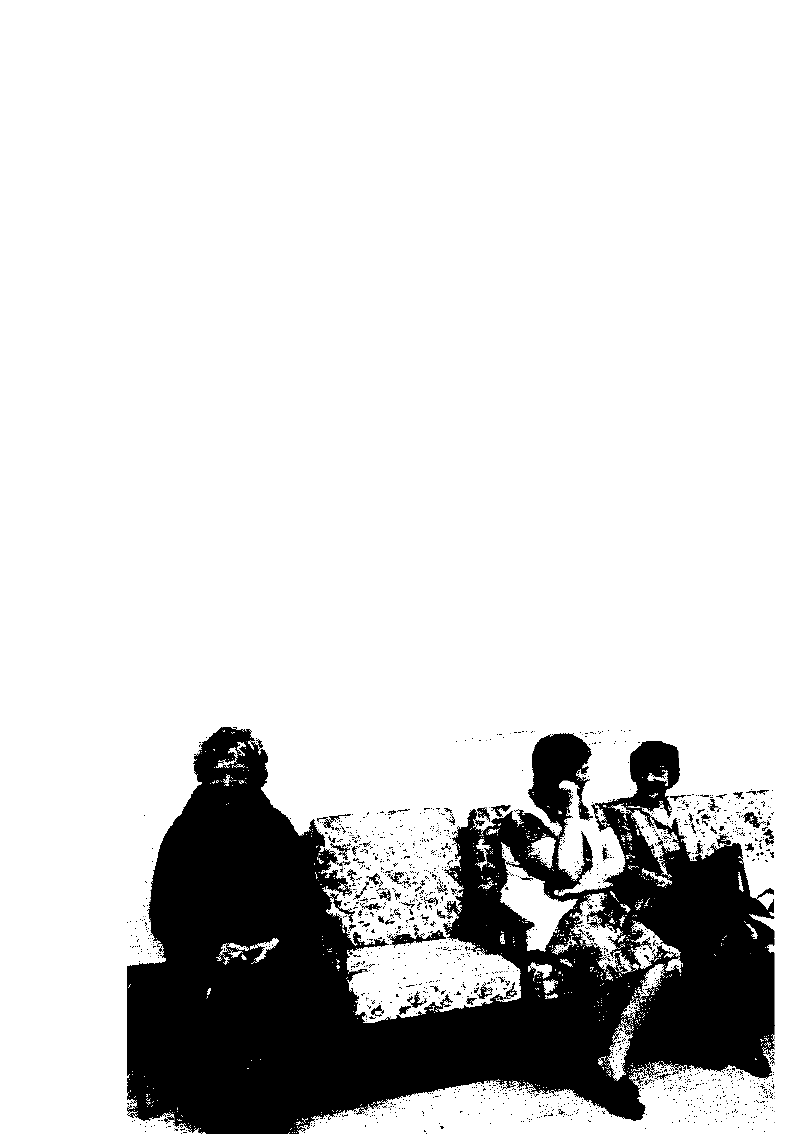Levine D.R. & Adelman M.B. Beyond Language. Intercultural Communication for English as a Second Language
Подождите немного. Документ загружается.


Time and Space Patterns 157
Space
"We shape our buildings and they shape us."
WINSTON CHURCHILL
Architectural Differences
[K]
When we travel abroad we are immediately impressed by the many
ways buildings, homes, and cities are designed. The division and organ-
ization of space lend character and uniqueness to villages, towns and
cities. Yet, architectural differences may also cause confusion or discom-5
fort for the traveler. In the following example, a group of Americans
living in a country in South America reacted emotionally to the architectural
differences they observed.
The Latin house is often built around a patio that is next to the sidewalk
but hidden from outsiders behind a wall. It is not easy to describe the
degree to which small architectural differences such as this affect out-
siders. American . . . technicians living in Latin America used to com-
plain that they felt "left out" of things, that they were "shut off." Others
kept wondering what was going on "behind those walls."
3
[L]
The separation of space inside homes may also vary from culture to
culture. In most American homes the layout of rooms reveals the sepa-
rateness and labeling of space according to function—bedroom, living
room, dining room, playroom, and so on. This system is in sharp con-
5 trast to other cultures where one room in a house may serve several
functions. In Japan, homes with sliding walls can change a large room
into two small rooms so that a living room can also serve as a bedroom.
[M]
When a home or a city's design is influenced by another culture, the
"native" architecture can be lost or disguised. For example, a French
architect was asked to design Punjab, the capital city in Chadigarh,
India. He decided to plan the city with centralized shopping centers
5 which required public transportation and movement away from the
village centers. Eventually the Indians stopped meeting each other
socially in their small neighborhoods. Apparently, the introduction of a
non-Indian style of architecture affected some of the cultural and social
patterns of those living in the city.
Privacy and the Use of Space
[N]
Architectural design influences how privacy is achieved as well as
how social contact is made in public places. The concept of privacy is not

158 Time and Space Patterns
unique to a particular culture but what it means is culturally determined.
For example,
. . . according to Donald Keene, author of
Living Japan,
there is no
Japanese word for privacy. Yet one cannot say that the concept of privacy
does not exist among the Japanese but only that it is very different from
the Western conception.
4
5 Similarly, there is no word in the Russian language that means exactly
the same as the English word 'privacy'.
[O] People in the United States tend to achieve privacy by physically
separating themselves from others. The expression "good fences make
good neighbors" indicates a preference for privacy from neighbors'
homes. If a family can afford it, each child has his or her own bedroom.
5 When privacy is needed, family members may lock their bedroom doors.
When the American wants to be alone he goes into a room and shuts the
door—he depends on architectural features for screening. . . . The
English, on the other hand, lacking rooms of their own since childhood,
never developed the practice of using space as a refuge from others.
5
In some cultures when individuals desire privacy, it is acceptable for
them simply to withdraw into themselves. That is, they do not need to
remove themselves physically from a group in order to achieve privacy.
[P] Young American children learn the rule "knock before you enter"
which teaches them to respect others' privacy. Parents, too, often follow

Time and Space Patterns 159
this rule prior to entering their children's rooms. When a bedroom door
is closed it may be a sign to others saying, "I need privacy," "I'm angry,"
5 or "Do not disturb . . . I'm busy." For Americans, the physical division
of space and the use of architectural features permit a sense of privacy.
[Q]
The way space is used to enable the individual to achieve privacy, to
build homes or to design cities is culturally influenced. Dr. Hall sum-
marizes the relationship between individuals and their physical sur-
roundings:
Man and his extensions constitute one interrelated system. It is a mis-
take . . . to act as though man were one thing and his house or his
cities, . . . or his language . . . were something else.
6

160 Time and Space Patterns
Comprehension Questions'
Choose the best answer for the following questions. You will find the
answer either stated directly or indirectly in the reading passage.
Time
1.
Susan Anthony's use of time is used in the introduction of this
reading to exemplify:
a.
Bureaucratic efficiency.
b.
Cultural influences.
c.
A career woman's day.
2.
People who arrive late for appointments may be considered; [A]
a.
Impolite.
b.
Dependable.
c.
Lazy.
3.
In the United States the child who must go to bed early, be prompt at
school, or bring a tardy slip if he is late: [B]
a.
Is learning the importance of time and punctuality in his culture.
b.
Is learning to disobey his parents and teachers.
c.
Is being punished for disobeying his mother and school officials.
4.
Social etiquette in the United States allows people: [C]
a.
To be a few minutes late for interviews and business meetings.
b.
To come early to parties.
c.
To be up to a half-hour late for some parties.
5.
The idea that "time is tangible" in the American culture means: [E]
a.
Time is a material object (such as an alarm clock).
b.
Time cannot be wasted.
c.
Time is treated and expressed as though it were a possession.
6.
The examples of office calendars and separate business activities
illustrate the idea that: [F]
a.
Activities are usually done "one at a time."
b.
The customer is not as important as the secretary.
c.
Americans don't like to socialize in the office.
7.
The American orientation toward the future might be demonstrated
by the: [H]
The capital letter in brackets refers to the corresponding paragraph in the reading.

Time and Space Patterns 161
a.
Presence of religious institutions.
b.
Preference for "old-fashioned" parents.
c.
Limited role of tradition.
8. Which of the following positions do the authors take on the use of
time in the American culture? [I]
a.
The fast pace produces nothing but ulcers and high blood pres
sure.
b.
The authors do not take a position but, rather, describe different
attitudes.
c.
The fast pace permits technological and scientific progress which
benefits all people.
Space
1.
Sir Winston Churchill's quote, "We shape our buildings and they
shape us," means:
a.
We cannot live without buildings.
b.
The shapes of buildings determine culture completely.
c.
We influence our environment and it influences us.
2.
Why did American technicians in Latin America complain of feeling
"left out" and "shut off"? [K]
a.
They weren't accustomed to the architectural style of walls around
houses.
b.
They were prevented from learning the family secrets of the Latin
Americans living inside the houses.
c.
They were unable to find the entrances to the Latin American
homes.
3.
Why did the Indians' social life change after the foreign architect
designed the capital city? [M]
a.
Public transportation destroys social life in big cities.
b.
Local neighborhoods were no longer the centers of social
activities.
c.
All non-Indian architecture discourages social interaction.
4.
What is the point Donald Keene makes in his book
Living Japan?
[N]
a.
The Japanese view of privacy is not the same as the Western view.
b.
Privacy is only a Western concept.
c.
The Japanese don't need privacy and therefore don't have a word
for it.

162 Time and Space Patterns
Vocabulary List
Time
Paragraph A
Parag aph B
r Paragraph C
Paragraph D
awareness
punctuality
dependable
conditioned
disoriented
tardy
fine
etiquette
amusing
scheduled
pace
celebrations
sacred
rude
Paragraph E
Paragraph F
Paragraph G
Paragraph H
tangible
slots
characteristic
rigid
possession
prior
contemporary
accommodate
versions
engagements
Paragraph I
Parag aph ]
r
urban
intuitive
benefits
Phrases and Expressions
to take [something] for granted [A]
on time [B]
time is money [C]
do one thing at a time [F]
a time and place for everything [F]
drop by [F]
old-fashioned [H]
generation gap [H]
keep up with the times [H]
Choose the appropriate synonym (or word closest in
meaning) from the list and rewrite each sentence, replacing
the italicized word.
Change
ense singular and plural, and part
t ,
of speech when necessary.
Vocabulary Exercises
A.
Synonyms
holy
confuse
speed
festivals
manners
late
funny
recognition
impolite
promptness
The capital letter in brackets refers to the corresponding paragraph in the reading.

Time and Space Patterns 163
1.
Travelers can feel
disoriented
in foreign cultures. [A]
2.
An
awareness of
the problem is needed before it can be
solved. [A]
3.
Sending "thank you notes" a day or two after attending dinner parties
is considered to be good social
etiquette.
[A]
4.
Long distance runners increase their running
pace
gradually. [A]
5.
Dancing and eating are two favorite activities at many
cele
bra ions. [A]
t
6.
For many people the Bible is a
sacred
book. [A]
7.
As a child he learned that yawning while others are speaking is
rude.
[A]
8.
Some people believe that
punctuality
in others is characteristic of a
responsible person. [B]
9.
The class met so early in the morning that the student was frequently
tardy. [B]
10.
Teachers who tell
amusing
stories in class are popular. [B]
B. First choose the correct word for the definitions. Then fill in the blanks in
Definitions
the sentences below the definitions. Note:
You may have to change the
grammatical form of the word placed in the sentence.
dependable [C]
tangible [E]
accommodate [F]
fine [C]
possession [E]
engagements [F]
scheduled [C]
slots [F]
conditioned [D]
prior [F]
1.
trained
____________________
The dog was
____________________
to sit when his master said, "Sit
down."
2.
openings, holes
_____________________
Large packages cannot fit into small
_____________________
in the
mailbox.
3.
having form and substance; able to be touched
__________________
She wanted
_____________________
proof of his love.
4.
trustworthy; reliable
____________________

164 Time and Space Patterns
The friendship between the two girls ended when one showed that
she wasn't
____________________
.
5.
to make fit; adjust
____________________
The student was unable to
_____________________
the professor's
busy schedule and consequently did not visit him during office
hours.
6.
previous; earlier
_____________________
_________________
commitments prevented his going to the
party.
7.
a sum of money to be paid as punishment
____________________
In some states, throwing trash from the car window may result in a
$500
______________________
8.
appointments
____________________
The president of the bank arranged a dinner
_____________________
with one of the bank employees.
9.
anything someone owns
____________________
Her wedding ring was her most valuable
_____________________
.
10.
planned for a certain time
____________________
The busy executive
_____________________
every minute of the day.
C. Choose the word that
best
defines the italicized word.
Multiple
Choice 1.
Redwood forests are
characteris ic
of parks in Northern Cali-
t
fornia. [G]
a.
rare in
c. popular in
b.
cultivated in
d. typical of
2.
His boss was so
rigid
that he never listened to new ideas. [H]
a.
inflexible
c. harsh
b.
authoritarian
d. angry
3.
The students attended a class entitled
"Contempora y
Issues" in which
r
they discussed social, political, and economic problems. [H]
a.
current
c. humane
b.
historical
d. contemptuous

Time and Space Patterns 165
4.
Since there were five different
versions
of the accident, it was difficult
to know what really happened. [H]
a.
outcomes
c. quotations
b.
interpretations
d. paragraphs
5.
Life in
urban
areas is more hurried than life in the countryside. [I]
a.
farm
c. city
b.
residential
d. street
6.
The major
benefit
of working with the company was the opportunity to
travel. [I]
a.
gift
c. problem
b.
advantage
d. result
7.
Some people seem to be more
intuitive
than others. [J]
a.
perceptive
c. ignorant
b.
concerned
d. apathetic
Conversational Activities
A. The following story humorously describes the daily life of one American
Use of
Time
student. The story is told from the point of view of his foreign roommate. Read
the passage and complete the exercise below.
Robert Rushmore (R.R.) tells me to use time wisely, but I think he
abuses time. He crams a thousand activities into what he calls "just a
second." The busier the better—that's R.R.'s motto. He moves fast, he
eats fast, he talks fast, he even got married and divorced fast.
From the moment my roommate wakes up, he tries to beat the clock.
The alarm buzzes; he jumps up, washes quickly, snatches a piece of
toast, gulps down a cup of coffee, and crams for his classes. He has a
special watch with a built-in alarm so he can time his arrival to class three
minutes before it begins. He uses these three fleeting minutes to proof-
read his homework or to continue reading the morning paper.
Once when I borrowed his notes I found that 50 percent of the words
were abbreviated. He even abbreviates his name when he writes per-
sonal notes. Once the bank called and told him that "stamped" signatures
were not allowed on his checks.
What's really strange is although R.R. doesn't have very much
money, he prefers to call people long distance rather than write letters.
However, he does send manufactured greeting cards and get-well cards
for special occasions. At Christmas time all his friends got a Xerox letter.
R.R. is a lot of fun, but the way he uses time is exhausting. Last
week we decided to double-date. I thought we'd have a quiet dinner at
home and enjoy an evening of conversation. R.R. offered to make the

166 Time and Space Patterns
meal; quickie spaghetti, precooked French bread, and instant pudding. We
spent only forty-five minutes for dinner and then hurried to catch an 8
P
.
M
.
movie. Afterwards we went dancing. By 2
A
.
M
.
I was dragging my feet.
Sometimes I wonder if R.R. ever tries to slow down his pace. He says
that he would like to stop the world and get off but that he doesn't have time.
I don't know if that is true . . . only time will tell.
Directions:
In the columns, list all the verbs, adjectives, adverbs, and expressions
in the story that are related to time or saving time. You will find
at least
6 verbs (including two-part verbs), 2 adverbs, 6 adjectives, and 4 ex-
pressions.
verbs
adverbs adjectives
expressions
Discuss:
What are the advantages and disadvantages of the way R.R. uses
time?
What are some expressions or words in your language which reflect
the way people use time?
The following are additional American proverbs and expressions on the
subject of time. What does each expression mean?
A stitch in time saves nine.
Time is money
